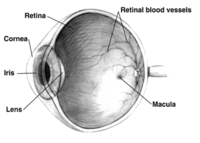
Photo from wikipedia
Alzheimer's disease (AD) is a neurodegenerative disorder which is characterized by increasing dementia. It is accompanied by the development of extracellular β-amyloid plaques and neurofibrillary tangles in the gray matter… Click to show full abstract
Alzheimer's disease (AD) is a neurodegenerative disorder which is characterized by increasing dementia. It is accompanied by the development of extracellular β-amyloid plaques and neurofibrillary tangles in the gray matter of the brain. Histology is the gold standard for the visualization of this pathology, but also has intrinsic shortcomings. Fully three-dimensional analysis and quantitative metrics of alterations in the tissue structure require a complementary approach. In this work we use X-ray phase-contrast tomography to obtain three-dimensional reconstructions of human hippocampal tissue affected by AD. Due to intrinsic electron density differences, tissue components and structures such as the granule cells of the dentate gyrus, blood vessels, or mineralized plaques can be identified and segmented in large volumes. Based on correlative histology, protein (tau, β-amyloid) and elemental content (iron, calcium) can be attributed to certain morphological features occurring in the entire volume. In the vicinity of senile plaques, an accumulation of microglia in combination with a loss of neuronal cells can be observed.
Journal Title: NeuroImage
Year Published: 2020
Link to full text (if available)
Share on Social Media: Sign Up to like & get
recommendations!